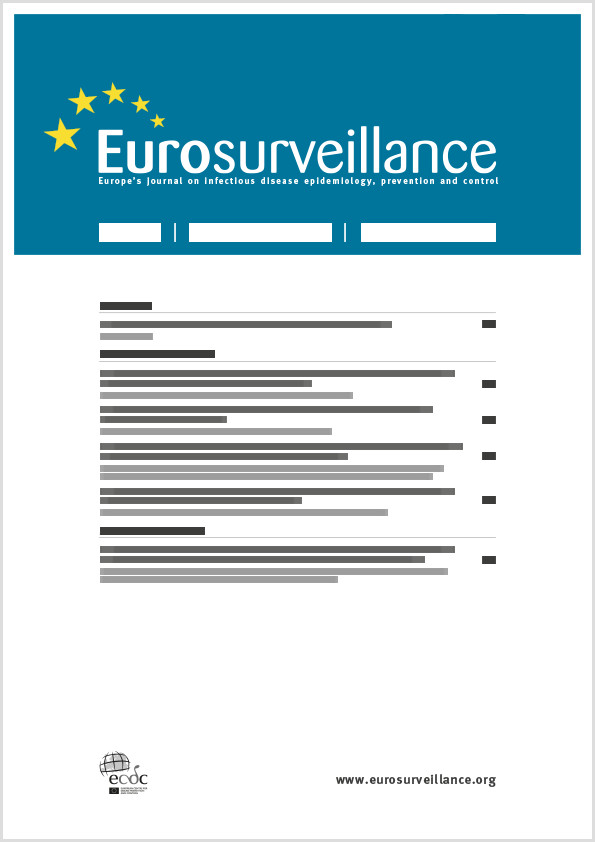- Home
- Eurosurveillance
- Previous Issues
- Volume 30, Issue 30, 31/Jul/2025
Eurosurveillance - Volume 30, Issue 30, 31 July 2025
Volume 30, Issue 30, 2025
- Rapid communication
-
-
-
Peanut butter confirmed as the source in a case of infant botulism, United Kingdom, 2024
More LessA 6-month-old infant was hospitalised with suspected infant botulism after being given peanut butter to reduce their risk of developing peanut allergy. Clostridium botulinum type A was detected in their faeces and the peanut butter by PCR and culture. Whole genome sequencing confirmed identical strains, identifying the peanut butter as the source of infection. The infant was treated with human-derived antitoxin Botulism Immune Globulin Intravenous (Human) (BIG-IV) and recovered well. This case highlights potential botulism risk with early peanut introduction.
-
-
-
Ongoing increase in autochthonous Salmonella Enteritidis infections, the Netherlands, June 2023 to June 2025
More LessSalmonella Enteritidis (SE) cases in humans have increased in the Netherlands, from an annual average of 281 (2017–2019) to 427 in 2023, 401 in 2024 and 209 in 2025 (January–June). This rise is paralleled by a 2.5-fold increase in SE-positive laying hen flocks. Genomic surveillance shows numerous small clusters, suggesting a diffuse transmission rather than a single point-source outbreak, which complicates outbreak investigations. Coordinated interventions in the laying hen sector are urgently needed to mitigate public health risks.
-
- Top
-
- Perspective
-
-
-
Early adopters of 6-month levofloxacin as rifampicin-resistant tuberculosis preventive treatment regimen in the WHO European Region, 2023
More LessTuberculosis (TB) preventive treatment (TPT) is crucial for preventing infection with Mycobacterium tuberculosis from progressing to TB disease, especially among people in high-risk groups. The expansion of novel TPT regimens for drug-susceptible TB is a notable advancement in TB care. However, managing contacts of drug-resistant TB patients remains a major challenge, particularly in Eastern Europe and Central Asia. In 2020, the World Health Organization (WHO) recommended TPT for high-risk household contacts of multidrug-resistant (MDR) or rifampicin-resistant (RR) TB patients; this was further reinforced in 2024 with a recommendation of a 6-month levofloxacin (6-Lfx) regimen. This Perspective discusses the early adoption of 6-Lfx for MDR/RR-TPT in the WHO European Region. In 2023, 38 of 53 WHO European Region countries reported on 6-Lfx use, with only eight confirming its use for MDR-TB contact persons. Accelerating the adoption of the 6-Lfx regimen and other evidence-backed TPT regimens is crucial for achieving TB elimination in the WHO European Region. Addressing challenges such as slow uptake of the recommendations, low awareness in affected communities and resource shortages are essential for success.
-
SDG 3: hepatitis
-
-
Standardising monitoring data on drug-related infectious diseases among people who inject drugs in Europe – an update of the European Union Drugs Agency technical protocol, 2024
More LessDrug-related infectious diseases (DRID), such as HIV, hepatitis B virus (HBV) and hepatitis C virus (HCV), contribute to high morbidity and mortality among people who inject drugs (PWID). The European Union Drugs Agency (EUDA) is responsible for monitoring DRID and related behaviours for PWID in Europe. We updated the EUDA DRID technical protocol which covers all steps from planning to data analysis needed for a survey among PWID. Drug-related infectious disease-specific indicators were revised. To enable a more effective monitoring of the current epidemiological situation, we added specific core indicators, such as prevalence of viraemic HBV, HCV and HIV care cascades and harm reduction-related indicators. HIV pre-exposure prophylaxis and take-home naloxone were added as optional indicators. The process was informed by a European working group, who shared best-practice examples of (repeated) cross-sectional and cohort surveys using different methods in various settings. To reach the World Health Organization’s goal of ending HIV and the viral hepatitis epidemics, comprehensive DRID monitoring among the disproportionately affected PWID population is needed.
-
- Top
- Miscellaneous
-
Volumes & issues
-
Volume 30 (2025)
-
Volume 29 (2024)
-
Volume 28 (2023)
-
Volume 27 (2022)
-
Volume 26 (2021)
-
Volume 25 (2020)
-
Volume 24 (2019)
-
Volume 23 (2018)
-
Volume 22 (2017)
-
Volume 21 (2016)
-
Volume 20 (2015)
-
Volume 19 (2014)
-
Volume 18 (2013)
-
Volume 17 (2012)
-
Volume 16 (2011)
-
Volume 15 (2010)
-
Volume 14 (2009)
-
Volume 13 (2008)
-
Volume 12 (2007)
-
Volume 11 (2006)
-
Volume 10 (2005)
-
Volume 9 (2004)
-
Volume 8 (2003)
-
Volume 7 (2002)
-
Volume 6 (2001)
-
Volume 5 (2000)
-
Volume 4 (1999)
-
Volume 3 (1998)
-
Volume 2 (1997)
-
Volume 1 (1996)
-
Volume 0 (1995)
Most Read This Month

-
-
Detection of 2019 novel coronavirus (2019-nCoV) by real-time RT-PCR
Victor M Corman , Olfert Landt , Marco Kaiser , Richard Molenkamp , Adam Meijer , Daniel KW Chu , Tobias Bleicker , Sebastian Brünink , Julia Schneider , Marie Luisa Schmidt , Daphne GJC Mulders , Bart L Haagmans , Bas van der Veer , Sharon van den Brink , Lisa Wijsman , Gabriel Goderski , Jean-Louis Romette , Joanna Ellis , Maria Zambon , Malik Peiris , Herman Goossens , Chantal Reusken , Marion PG Koopmans and Christian Drosten
-
- More Less


